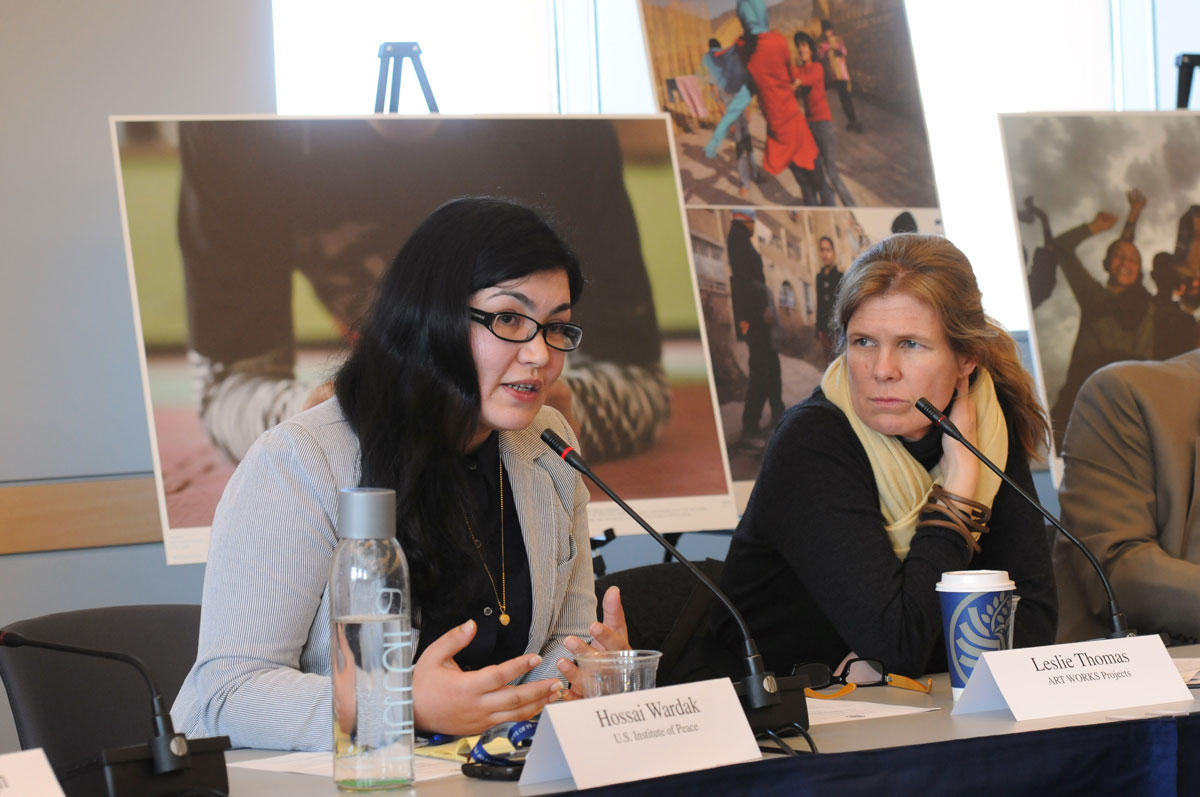To the backdrop of stunning photographs illustrating the achievements and remaining hurdles for women in Afghanistan, a USIP expert and the recipient of a U.S. award for courage joined other advocates in an urgent call for more Afghan women to be consulted in major decisions of the transition.

To the backdrop of stunning photographs illustrating the achievements and remaining hurdles for women in Afghanistan, a USIP expert and the recipient of a U.S. award for courage joined other advocates in an urgent call for more Afghan women to be consulted in major decisions of the transition.
Hossai Wardak, an Afghanistan senior expert at USIP and deputy director of the Afghan nonprofit Equality for Peace and Democracy, and Wazhma Frogh, who received one of the Secretary of State's Award for International Women of Courage in 2009, told an audience at the Institute on March 15 that female leaders in their country continue to be left out of critical decisions regarding the future of their country.
“There is a lot that has been done, especially in the last 10 to 11 years. We have achieved so much,” said Wardak. “A lot has been done, and still [there’s] a long way to go.”
USIP’s Center of Innovation in Gender and Peacebuilding hosted the event in conjunction with the Washington showing of an exhibit of photographs illustrating the status of women and girls in Afghanistan. The exhibit, “Women Between Peace and War in Afghanistan,” was displayed the previous day during an event on Capitol Hill to update members of Congress and the public on conditions in Afghanistan. The photo display is a project of Chicago-based ArtWorks Projects, which aimed to highlight “a group of people that we were worried would fall off the radar,” Executive Director Leslie Thomas said.

USIP’s Hossai Wardak addresses panel discussion on women in Afghanistan with Leslie Thomas, founding executive and creative director of Art Works Projects, which organized the exhibit shown..
“What is so important about these pictures is that it doesn’t show us as mere victims,” Frogh told the USIP audience.
While one photograph shows a woman getting delayed medical treatment for postpartum complications who later died, another image depicts a midwife in training preparing an injection of painkiller for a patient. In another picture, a pregnant woman completely covered in a traditional blue burka waits by the road on a barren ridge for transportation to a hospital, while another photo shows the face of a vibrant female member of Parliament in a pink chador, or head covering, participating in a legislative debate.
“That’s the story of Afghan women – that mixed picture that comes from Afghanistan,” said Frogh, who is a co-founder of Afghanistan’s first research institute focusing on women, peace, and security and the former country director of Global Rights Afghanistan.
Women still aren’t included as much as they should be in Afghanistan’s decision-making, especially regarding the transition, both Frogh and Wardak noted.
Commanders in the NATO-led military coalition should include Afghan women more substantively in transition deliberations, Frogh said. And in monitoring conditions as the coalition hands over territory in phases to Afghan military forces and police, official data should reflect the effect on women and whether their security increases or decreases as a result, she said.
“The security of Afghan women needs to be part of the transition process,” said Frogh. She won her 2009 State Department recognition for her campaigns against domestic violence, marital and child rape and sexual violence in Afghanistan.
The backlash against women’s progress in Afghanistan is clear, she said. In Laghman Province, two female leaders were assassinated within six months, both of them the women’s affairs chiefs, and the ministry as a result hasn’t been able to persuade anyone to replace them for fear that the successor might be targeted as well.
Preparations for the 2014 presidential election also need to include approaches for increasing the number of women who vote, Wardak and Frogh said. That will require sufficient resources from international donors, led by the U.S., to ensure legitimate elections, Frogh said.
Frogh said she’s often asked who is likely to win the presidential election to succeed President Hamid Karzai, and she replies that that’s less important than ensuring a credible procedure that encourages women to vote and ultimately gives Afghans confidence in their next government. “I’m not worried about the outcome, but the process matters so much,” Frogh said.
Standards already have fallen low for how inclusive the election will be, Wardak said, because time is short and security is still an issue in many potential polling locations. It may also be difficult to persuade more women to vote this time because of disillusionment with representatives who’ve been elected in the past, including some female members of Parliament, who promised much but have delivered little, she said. “The accomplishments” of the past 10 to 11 years, Frogh said, “are very much under the shadow of the challenges.”
How can Afghan women become more involved in the decisions of the government and the international community? Weigh in by submitting a comment below.